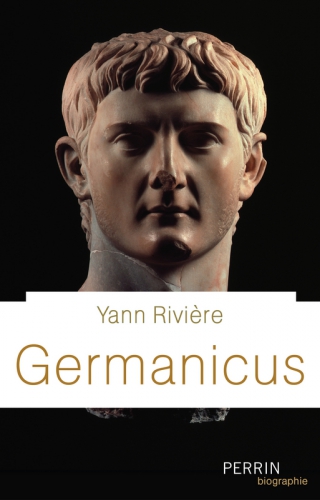jeudi, 09 mars 2017
GERMANICUS de Yann RIVIERE
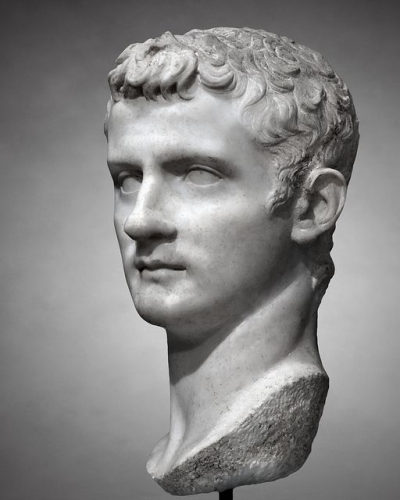
GERMANICUS de Yann RIVIERE
par Hubert de Singly
Ex: http://www.culture-chronique.com
Le dernier ouvrage de Joël Schmidt “La mort des César” raconte avec beaucoup de talent la fin des soixante dix empereurs romains qui se succédèrent à la tête de l’Empire jusqu’à sa fin. Mais il existe une catégorie de princes qui n’accédèrent jamais à la magistrature suprême alors même qu’ils en avaient l’étoffe. Ce fut le cas de Germanicus qui mourut à 34 ans à Antioche manquant une consécration qui lui tendait les bras. Yann Rivière qui connait parfaitement l’histoire politique et juridique de la Rome Antique nous propose une biographie serrée de plus de cinq cents pages de celui qui fut le petit fils de Marc Antoine, l’époux d’Agrippine et le père de Galigula.
D’emblée l’historien s’interroge. L’Empire n’aurait-il pas été plus puissant si Germanicus n’était pas mort si jeune ? Son entreprise de consolidation de la domination romaine en Orient n’aurait-elle pas été menée à son terme? S’il avait vécu, le roi des Parthes qui a pleuré sa mort n’aurait-il pas pas vécu en bonne entente avec Rome au cours des années suivantes plutôt que de s’engager dans une guerre qui vida les caisses de l’Empire pour le contrôle de l’Arménie. Toutes ces hypothèses restent évidemment au conditionnel mais elles en disent long sur cette personnalité hors du commun. En effet peu de ses contemporains auraient pu imaginer que le fils de Livie et de Marc Antoine occuperait une telle place dans l’Etat Romain et qu’il contribuerait autant à la défense de l’Empire. Rappelons qu’il brilla avec ses légions en Illyrie et qu’il effaça le désastre de Varus en Germanie en infligeant une cruelle défaite au chef légendaire Arminius. La suite de son ascension se poursuit en Orient où il consolida la paix et joua un rôle politique de premier plan. Il mourut persuadé qu’on l’avait empoisonné ce qui est bien possible et ce qui ne déplut pas forcément à Tibère qui assistait l’ascension de Germanicus avec inquiétude. Reste que dans toutes les régions où il passa son souvenir resta vif longtemps après sa disparition.
Ce “Germanicus” de Yann Rivière se lit comme un roman. Nous traversons l’Empire au côté de l’un des personnages les plus flamboyants que Rome enfanta. L’ouvrage est à fois un formidable récit et une minutieuse reconstitution historique. L’une des meilleures biographies historiques de l’année.
Hugues DE SINGLY
CULTURE-CHRONIQUE.COM encourage ses lecteurs à se rendre en librairie afin de soutenir le réseau des librairies françaises. Vous pouvez aussi cliquer sur le logo "Lalibrairie.com", votre commande sera alors envoyée chez le libraire de votre choix. Enfin, hormis "Amazon", la plupart des librairies en ligne que nous vous proposons sont aussi des librairies de centre-ville que nous vous encourageons à découvrir. La santé du livre dépend de la santé des librairies.
En savoir plus sur http://www.culture-chronique.com/chronique.htm?chroniqueid=1687#XddOW37BipCFt0BJ.99
22:04 Publié dans Histoire, Livre, Livre | Lien permanent | Commentaires (0) | Tags : germanicus, livre, antiquité romaine, rome antique, rome, empire romain, histoire, germanie antique, philologie classique, humanités gréco-latines |  |
|  del.icio.us |
del.icio.us |  |
|  Digg |
Digg | ![]() Facebook
Facebook
mardi, 03 janvier 2017
Alemanni
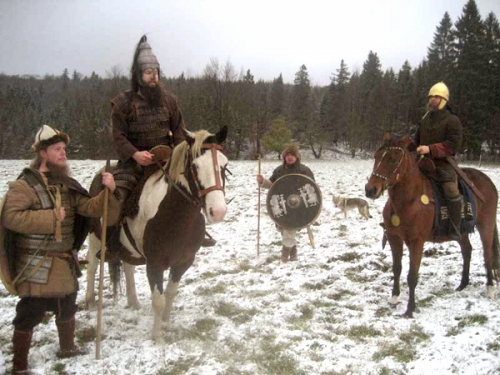
Alemanni
Definition
The Alemanni (also known as the Alamanni and the Alamans, meaning "All Men" or "Men United") were a confederacy of Germanic-speaking people who occupied the regions south of the Main and east of the Rhine rivers in present-day Germany. Many historians claim that the Alemanni first enter the historical record in 213 CE when Cassius Dio records the campaigns of Caracalla and his duplicitous dealings with the Alemanni. It is true that the name "Alemanni" first appears in Cassius Dio but, if one accepts that the Alemanni and the Suebi (or Suevi, who appear in earlier records) were the same (as not all do), then their first mention comes in 98 CE in Tacitus' Germania. They were a constant threat to the Roman Empire from 213 CE until they were defeated by Julian at the Battle of Strasbourg in 357 CE and then again by Valentinian I in 367 CE. After the Battle of Strasbourg, Julian entered into treaties with the Franks of Gaul who were then left alone by Rome. They were able to stabilize their communities and grow in power until, in 496 CE, the Frankish king Clovis conquered the Alemanni tribes and absorbed them into his kingdom. After this, their name lived on in the language of the region they had once inhabited and in the name given to Germany, Allemagne, in French and other languages.
APPEARANCE & RELIGION
The Roman senator and historian Tacitus (56-117 CE) wrote of the Suevi in the 1st century CE, claiming they controlled the better part of the region known as Germania. He links the Alemanni with the Hermunduri, another Germanic tribe, but this claim has been contested by modern-day scholarship. The Suevi Tacitus depicts sound very much like the later Alemanni, in that they were a confederation of different tribes, which may have even included the Cherusci (famous for their leader Arminius' destruction of Varus' three legions in Teutoburger Wald in 9 CE). Tacitus is the first writer to note the Suevi's distinctive hair styles and religious practices. He writes:
We have now to speak of the Suevi; who do not compose a single state, like the Catti or Tencteri, but occupy the greatest part of Germany and are still distributed into different names and nations, although all hearing the common appellation of Suevi. It is characteristic of this people to turn their hair sideways, and tie it beneath the poll in a knot.
By this mark the Suevi are distinguished from the rest of the Germans; and the freemen of the Suevi from the slaves. Among other nations, this mode, either on account of some relationship with the Suevi, or from the usual propensity to imitation, is sometimes adopted; but rarely, and only during the period of youth.
The Suevi, even till they are hoary, continue to have their hair growing stiffly backwards, and often it is fastened on the very crown of the head. The chiefs dress it with still greater care and in this respect they study ornament, though of an undebasing kind. For their design is not to make love, or inspire it; they decorate themselves in this manner as they proceed to war, in order to seem taller and more terrible; and dress for the eyes of their enemies (Germania, 38).
Regarding religion, Tacitus writes that the Suevi were pagan and seem to have practiced a form of Druidism. Their chiefs were drawn from a tribe in the confederation known as Semnones who also served as high priests:
The Semnones assert themselves to be the most ancient and noble of the Suevi; and their pretensions are confirmed by religion. At a stated time, all the people of the same lineage assemble by their delegates in a wood, consecrated by the auguries of their forefathers and ancient terror, and there by the public slaughter of a human victim celebrate the horrid origin of their barbarous rites. Another kind of reverence is paid to the grove. No person enters it without being bound with a chain, as an acknowledgment of his inferior nature, and the power of the deity residing there. If he accidentally falls, it is not lawful for him to be lifted or to rise up; they roll themselves out along the ground. The whole of their superstition has this import: that from this spot the nation derives its origin; that here is the residence of the Deity, the Governor of all, and that everything else is subject and subordinate to him. These opinions receive additional authority from the power of the Semnones, who inhabit a hundred cantons, and, from the great body they compose, consider themselves as the head of the Suevi (Germania, 39).
The religious practices centered on chthonic locales, then, where a central deity held sway. Rivers, streams, glades, and valleys were often chosen as sacred ground for the energies which manifested themselves in these locales. As with many other ancient civilizations, the Suevi believed the soul had to cross a body of water to reach the afterlife and that the soul lived on after death. Suevi/Alemanni grave excavations have revealed that they were buried fully dressed and with personal items that they would need in the next world. These burial practices continued after they converted to Christianity sometime between the 6th and 8th centuries CE although, of course, their religious practices changed dramatically.
THE ALEMANNI & ROME
Although the Suevi have been identified with the later Alemanni, historians caution against equating the two without recognizing their differences over the centuries which separate Tacitus' account (98 CE) from Cassius Dio's (c. 229 CE). The scholar Guy Halsall writes, "It is unlikely that the situation which pertained in the mid-first century was at all relevant to the late Roman period. Tacitus' Germania is a minefield probably best avoided [in this regard]" (121). The scholar Peter Heather comments on this also, stating how unified the Alemanni appear in the work of Ammianus Marcellinus (c. 325-391 CE) while, "One of the central points brought home by even the quickest read of Tacitus' Germania is just how fragmented, in political terms, the Germanic world was at that date" (36). It is for this reason that historians usually cite Cassius Dio's account as the first mention of the Alemanni and ignore Tacitus' earlier description of the Suevi.
By the time of Dio's account, the Alemanni were largely Romanized from their long acquaintance with the Romans. Halsall writes how, in the border region of the Danube and the Roman Empire,
some of the Alemanni, who it has been suggested were formed at least partly by the Romans themselves from inhabitants of the agri decumates [a term possibly meaning 10 agricultural regions]and authorised barbarian settlers, occupied former Roman villa sites, such as at Wurmlingen in Baden Wurttemberg (128).
The Alemanni at this time wore Roman attire and emulated Roman social customs. Even so, they were not 'Romans' in the accepted sense of that word and maintained their own language and culture. Therefore, when they asked the emperor Caracalla for help against a neighboring tribe in 213 CE, he saw no reason why he should not conquer them instead. Cassius Dio writes:
Antoninus [Caracalla] made a campaign against the Alamanni and whenever he saw a spot suitable for habitation, he would order, "There let a fort be erected. There let a city be built." And he gave these places names relating to himself, though the local designations were not changed; for some of the people were unaware of the new names and others supposed he was jesting. Consequently he came to feel contempt for these people and would not spare even them, but accorded treatment befitting the bitterest foes to the very people whom he claimed to have come to help. For he summoned their men of military age, pretending that they were to serve as mercenaries, and then at a given signal — by raising aloft his own shield — he caused them all to be surrounded and cut down, and he sent horsemen round about and arrested all the others (78.13.4).
Whether the Alemanni were particularly hostile to Rome before this is not known, but they became one of Rome's most bitter enemies afterwards.
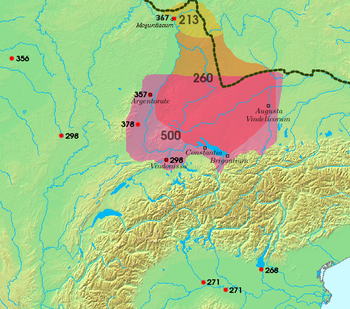
ENGAGEMENTS AGAINST ROME
- 256 CE: Gregory of Tours (c. 538-594 CE) famously wrote of the Alemanni invasion of Gaul in 256 CE under their king Chrocus. Chrocus led his army across the land, destroying the cities, churches, towns, and slaughtering the inhabitants until he was defeated at Arles and executed. Surviving members of his army were then either killed or absorbed into the Roman ranks as mercenaries.
- 259 CE: The Alemanni invaded Italy, ravaging the fertile Po Valley, until they were defeated at the Battle of Mediolanum by a Roman force led by emperor Gallienus.
- 268 CE: The Battle of Benacus was fought in 268/269 CE between the emperor Claudius II (supported by the later Emperor Aurelian) and the Alemanni. The Alemanni, allied with the Juthungi, invaded northern Italy and were met at Benacus by the Roman forces. The Romans again decisively defeated the Alemanni, killing most of them and scattering the rest.
- 271 CE: The Alemanni and Juthungi again invaded Italy, while the emperor Aurelian was busy repulsing Vandals on the Danube frontier. He marched his forces to meet the Alemanni threat but was ambushed and defeated at the Battle of Placentia. This defeat resulted in widespread panic throughout Rome, as the Juthungi marched toward the city which had no sizeable force to protect it. Aurelian regrouped, however, and chased the Juthungi, finally meeting them at the Battle of Fano where he defeated them completely, driving them into the Metaurus River where many of them drowned. The surviving Juthungi then sued for a peace which Aurelian rejected. He pursued them and their Alemanni allies and destroyed most of the force at the Battle of Pavia. Those Alemanni who survived were hunted down and killed trying to escape back home through the province of Raetia. Although he had stopped the invasion and destroyed the enemy, Aurelian recognized the need for better defenses for Rome and so ordered a new and stronger wall built around the city.
- 298 CE: The emperor Constantius defeated the Alemanni twice at the Battle of Lingones and then again at the Battle of Vindonissa.
- 356 CE: Julian, commanding his first military force (prior to becoming emperor), was surprised and defeated by the Alemanni at the Battle of Reims.
- 357 CE: Julian defeated the Alemanni at the Battle of Strasbourg, completely overwhelming their forces and capturing one of their most important leaders, Chnodomar (also known as Chnodomarius) who had mobilized the Alemanni for battle and led them from the front. Although Julian's victory subdued the Alemanni and allowed him to march into Germania, re-build and garrison Roman forts, and force tribute from the tribes, it did not destroy the Alemanni or disperse them. Peter Heather writes:
The defeat of Chnodomarius did not mean the total destruction of the alliance at whose head he had stood, as the defeats of his first-century counterparts such as Arminius and Maroboduus had done three centuries before. Not only were many of the lesser Alamannic kings who had participated in the battle left in place by Julian's diplomacy, but, within a decade of the battle, a new pre-eminent leader, Vadomarius, was worrying the Romans. He was skillfully removed by assassination, but then a third appeared in his place: Macrinus. Ammianus records three separate attempts by one of Julian's successors, Valentinian I, to eliminate Macrinus by capture and/or assassination, but eventually, pressed by events further east, the emperor gave in. Roman and Alamann met in the middle of the Rhine for a water-borne summit, where the emperor acknowledged Macrinus' pre-eminence among the Alamanni. Unlike in the first century, even major military defeat was not enough to destroy the larger Alamannic confederation (40-41).
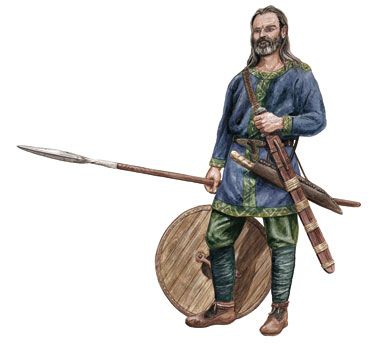 The "major military defeat" Heather refers to is not only the Battle of Strasbourg but the later Battle of Solicinium in 367 CE, in which Valentinian I defeated the Alemanni in the southwestern region of Germany. Even though he was victorious, the Alemanni were by no means broken and were still a formidable force some 80 years later when they joined the forces of Attila the Hun and took part in the Battle of the Catalaunian Plains against the Romans under Flavius Aetius in 451 CE. Even so, the Battle of Strasbourg severely limited their abilities to threaten Rome for years after. The historian Roger Collins writes,
The "major military defeat" Heather refers to is not only the Battle of Strasbourg but the later Battle of Solicinium in 367 CE, in which Valentinian I defeated the Alemanni in the southwestern region of Germany. Even though he was victorious, the Alemanni were by no means broken and were still a formidable force some 80 years later when they joined the forces of Attila the Hun and took part in the Battle of the Catalaunian Plains against the Romans under Flavius Aetius in 451 CE. Even so, the Battle of Strasbourg severely limited their abilities to threaten Rome for years after. The historian Roger Collins writes,
This single battle really turned the tide as far as the Alaman penetration of Gaul was concerned. It broke the Alamannic confederacy of tribes that had largely been built up and held together by the military credibility of Chnodomar, and for the first time enabled the Romans to take the initiative…Threatened with a Roman invasion of their own territory, the Alamans sought a truce (35).
Again, however, it must be noted that the confederacy was not disbanded nor did the Alemanni seem to consider themselves a conquered people.
THE FRANKISH CONQUEST OF THE ALEMANNI
First Julian, and then Valentinian I, entered into treaties with the confederacy of the people known as the Franks ("the fierce people"). In an effort to maintain the newly restored Roman city of Cologne, Julian blockaded the territory of the Franks, depriving them of much-needed trade goods, until they agreed to his terms. Collins comments on this, writing:
It is notable that Julian made no attempt to penetrate the marshy lands north of the Meuse that the Franks had occupied, and their continuing occupation of this area was tacitly accepted by the Romans. From this small start the subsequent Frankish occupation of all of Gaul would develop. This, it might be said, was `the birth of France'. In 357/8, however, what was achieved was a treaty of federation: Frankish occupation of Roman territory was accepted in return for their helping to defend the region (35).
This arrangement was good for the Franks, who began to steadily flourish, but not as beneficial to the Alemanni. By the time the Alemanni fought alongside the Huns in 451 CE at the Catalaunian Plains, the Franks had become powerful enough to be counted as allies of the Romans under Aetius. The Franks were united under the reign of their first king, Clovis I (466-511 CE), who then expanded the boundaries of Gaul to conquer western Europe. The Alemanni continued to inhabit the region of Germania until they were defeated by Clovis I at the Battle of Tolbiac in 496 CE and were subjugated by the Franks. Afterwards, some were assimilated into Frankish culture and took up residence in Gaul, while others continued to live in their former region under Frankish rule. Their name is remembered today in the Alemannic dialect of German, and the word for 'Germany' (Allemagne, Alemania) in many modern-day languages.
ABOUT THE AUTHOR
17:15 Publié dans archéologie, Histoire | Lien permanent | Commentaires (0) | Tags : archéologie, alamans, tribus germaniques, germanie antique, germanie, germains, histoire, rome antique, antiquité romaine |  |
|  del.icio.us |
del.icio.us |  |
|  Digg |
Digg | ![]() Facebook
Facebook
samedi, 23 janvier 2016
Hinterhalt in Germanien - Kampftechniken germanischer Krieger
Hinterhalt in Germanien - Kampftechniken germanischer Krieger
Germanien im Jahr 9 nach Christus: Die Römer sind auf dem Höhepunkt ihrer Macht und verfügen über die größte und stärkste Armee der Welt. Doch bei der Schlacht im Teutoburger Wald werden der römische Feldherr Varus und seine Legionen von den germanischen Stammeskriegern regelrecht niedergemetzelt. Was war das Geheimnis der germanischen Krieger? Der Ex-Berufssoldat und Kämpfer eines US-Sonderkommandos, Terry Schappert, ist Moderator der Reihe "Die Krieger". Er führt die Zuschauer durch die Welt der Krieger und Kämpfer aus allen Epochen der Geschichte.
00:05 Publié dans Histoire | Lien permanent | Commentaires (0) | Tags : histoire, germanie, germanie antique, guerriers germaniques, varus, arminius, empire romain |  |
|  del.icio.us |
del.icio.us |  |
|  Digg |
Digg | ![]() Facebook
Facebook
mardi, 27 octobre 2015
Arqueólogos alemanes encuentran el campamento de Varus en Germania
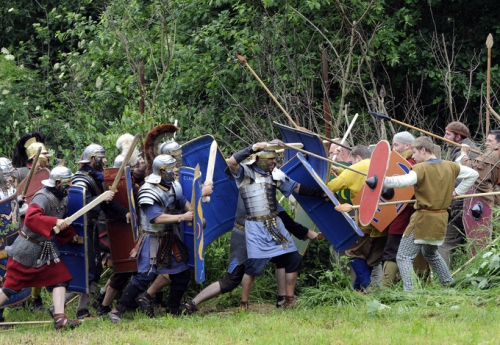
Arqueólogos alemanes encuentran el campamento de Varus en Germania
Ex: http://www.abc.es
Si los alemanes beben cerveza en lugar de vino, aliñan con mantequilla y no con aceite de oliva, o siguen hablando una lengua endiabladamente hostil a los herederos del latín es porque nunca fueron romanizados. Y se lo deben a Arminio, un líder germano que contuvo a las legiones e impidió la creación de una provincia romana en la margen derecha del Rin. La gesta de Arminio, sin embargo, se ha mantenido a lo largo de los siglos en la niebla del mito nacional germánico, puesto que el único testimonio arqueológico de su victoria era una piedra funeraria con el nombre del centurión Marcus Caelius y una inscripción que documenta que murió en la Batalla de Varus. Ahora, el reciente hallazgo arqueológico de un campamento romano en Baja Sajonia arroja una primera luz científica sobre la leyenda y ayuda a redibujar el mapa de la historia romana de Alemania.
Se trata de un campamento romano de tiempos de Cristo en lo que hoy es Wilkenburg, al sur de Hannover, en el que según los primeros indicios llegaron a concentrarse al menos durante unos cuantos días unos 20.000 soldados romanos fuertemente armados, lo que equivale a tres legiones y a una décima parte del total de las tropas del imperio. Es el primero de su tipo hallado en el norte de Alemania y concretamente estuvo ocupado, según las primeras mediciones, entre el año 12 a.C. y el 9 d.C.. Desde él parten además, en varias direcciones, rutas de 20 kilómetros en las que se encuentran otros pequeños campamentos auxiliares. Junto a restos de sandalias romanas, pinzas y fíbulas, en total vario cientos de objetos y restos, han sido halladas monedas de la época del emperador Augusto. Hay denarios romanos acuñados en Lyon y otras monedas de origen celta. Su pormenorizado estudio aportará precisión al descubrimiento, mientras el trabajo de campo ha cumplido ya sus primeros objetivos.
Fueron unas imágenes aéreas lo que llamó la atención de los arqueólogos estatales del Land de Baja Sajonia y comenzaron las excavaciones en un área de 500 por 600 metros. Harald Nagel, afanado en el repaso con detectores de metales de unas 30 hectáreas de terreno, se muestra prudente en su valoración del hallazgo. «Los estudios de las monedas están todavía en su fase preliminar y es pronto para sacar conclusiones», dice, pero reconoce que «el yacimiento demuestra que Hannover y sus alrededores fueron un punt de importancia histórica y estratégica muy superior a lo que se estimaba hasta ahora».
Al igual que las legiones de Varus, los trabajos arqueológicos han de vérselas con constantes y copiosas lluvias que convierten las trincheras de excavación en auténticos barrizales cada dos por tres. «Tácito ya describió sobre la batalla de Varus que llovían perros y gatos», recuerda el arqueólogo Hening Hassmann, que destaca el cruce de rutas norte-sur y este-oeste que fue elegido para instalar a las tropas romanas.
En efecto, en 1515, el humanista Ullrich von Hutten descubrió en el primer libro de los Anales de Tácito una referencia a «Arminius», de quien el historiador romano decía que había infligido una derrota a Roma cuando el imperio estaba en todo su esplendor. Tácito calificaba a Arminius como el verdadero liberador de Germania. Ullrich von Hutten tomó las lacónicas apreciaciones de Tácito sobre Arminius y publicó en 1529 un diálogo póstumo titulado «Arminius», que cultivaron los los protestantes para subrayar la independencia no ya ante la Roma imperial sino ante la iglesia romana.
Hay consenso entre los historiadores sobre que Arminio, un germano que había formado parte del ejército romano y en quien Varus confiaba, formó una alianza entre varias tribus bárbaras y le tendió una trampa a Varus para hacerse con el control de la región. Las legiones romanas sucumbieron a una emboscada que terminó en carnicería. El actual hallazgo, por su importancia y dimensiones, apunta por ahora solamente a dos posibles lecturas: o bien el mismo Tiberio subió más al norte de lo que se había pensado hasta ahora, o fue Varus el que llegó hasta Hannover para allí morir y poner fin a la expansión romana en Germania.
00:05 Publié dans archéologie | Lien permanent | Commentaires (0) | Tags : archéologie, légions de varus, varus, rome, rome antique, germanie, germanie antique, allemagne, archéologie |  |
|  del.icio.us |
del.icio.us |  |
|  Digg |
Digg | ![]() Facebook
Facebook
vendredi, 02 novembre 2012
Kampf um Germanien - Die Varusschlacht
Kampf um Germanien - Die Varusschlacht
00:05 Publié dans archéologie, Histoire | Lien permanent | Commentaires (0) | Tags : germanie antique, germains, rome, antiquité germanique, antiquité romaine, histoire, antiquité |  |
|  del.icio.us |
del.icio.us |  |
|  Digg |
Digg | ![]() Facebook
Facebook
mardi, 27 mars 2012
Le culte solaire chez les peuples germaniques

Frithjof HALLMAN:
Le culte solaire chez les peuples germaniques
Contrairement aux Grecs et aux Romains, qui adoraient des divinités solaires, les Germains considéraient que la puissance du soleil, qui donnait vie à tous les êtres, était, pour eux, une des puissances les plus sacrées. Les innombrables symboles solaires que l’on découvre sur les parois rupestres du Nord de l’Europe depuis l’âge du bronze, souvent sous la forme de roues solaires, en témoignent de manière fort éloquente. Certains d’entre ces symboles ont plus de 3500 ans. Jusqu’ici, il a été quasiment impossible d’interpréter avec précision ces signes gravés dans les rochers. Par ailleurs, le déchiffrement des signes trouvés, au nombre d’environ 7500, sur un rocher canadien, à Petersborough dans la province d’Ontario, nous donne l’espoir d’un jour pouvoir déchiffrer les milliers de grafittis de l’Ultima Thulé scandinave. C’est un professeur britannique, Barry Fell, qui nous a donné la clef d’un tel déchiffrement. Les deux alphabets de runes primitives, qu’il est parvenu à déchiffrer, il les a appelés “Tifinag” et “Ogham”. Son oeuvre peut se comparer au dévoilement du mystère des hiéroglyphes égyptiens par le Français Champollion et à la découverte du sens des anciens alphabets grecs du “Linéaire A” et du “Linéaire B” par Michael Ventris. Grâce à Champollion et à Ventris des pans entiers de la culture antique et protohistorique nous sont désormais accessibles.
Les spécialistes allemands des religions et des mythologies, le Dr. Wolfram Goegginger et le Prof. Gustav Mensching ont, dans un ouvrage reproduit récemment en facsimilé, Volksreligion und Weltreligion im deutschen Brauchtum (= Religion populaire et religion universelle dans les coutumes allemandes; Faksimile-Verlag, Brème, 266 pages, 1996) ont surtout mis en exergue les cultes solaires germaniques et souligné leur grande importance. Le livre, dans sa première édition, date de 1944 et avait été publié auprès d’une maison d’édition de Riga en Lettonie. L’ensemble du stock avait été détruit lors d’un bombardement allié, alors qu’on le transportait vers l’Allemagne. La nouvelle édition fait donc oeuvre utile. On considère désormais ce travail comme un ouvrage standard dans la littérature sur l’histoire des religions.
Thèse initiale du travail: au départ de la religion populaire germanique primitive, on peut évoquer diverses fêtes du printemps, du soleil et de l’hiver, assorties de traditions précises, tant et si bien que la pratique de cette religion populaire peut être considérée comme une création purement germanique. On ne s’étonnera pas, dès lors, que l’Eglise, au moment où le christianisme pénétrait dans l’espace germanique et scandinave, ait tout mis en oeuvre pour détruire ces traditions mythiques bien ancrées depuis la nuit des temps, comme d’ailleurs toutes les autres coutumes et monuments “païens” de nos lointains ancêtres.
On comprendra aisément que des populations contraintes de vivre dans de sombres forêts pendant près d’une demie année d’obscurité vont adorer l’astre solaire avec une vénération plus forte que les peuples du Sud.
En partant d’une présentation de l’essence de la religion chrétienne, pour laquelle, comme pour l’islam et le bouddhisme, l’individu est central, nos deux auteurs montrent, dans leur ouvrage, que la religiosité des anciens Germains est affirmatrice de la vie au contraire de la religion chrétienne qui méprise le monde et s’affirme anti-vitaliste.
Nous n’avons pas la place ici d’énumérer, même sommairement, toutes les coutumes principales de la liturgie annuelle pratiquée par nos ancêtres, raison pour laquelle il conviendrait d’acheter et de lire ce livre remarquable, qui comble une formidable lacune dans l’histoire des pratiques religieuses en Europe.
Nos auteurs évoquent notamment les combats printaniers contre les dragons, représentant les puissances hivernales et mortifères, des fêtes de la fertilité et des rites liés aux plus anciennes divinités (Odin, Thor, Frigga, etc.), ainsi que les fêtes de l’Ostara et du Huld, qui, elles, évoquent la reprise de parole de Dieu. Parmi les cultes commentés, signalons le “labourage sacré”, au moment où commence le printemps; ces cultes indiquent que ces peuples avaient acquis un degré élevé de culture comme le montrent aussi les nombreux dessins rupestres où figurent des chariots et des nefs à haute étrave ou haut étambot. Ces populations n’étaient donc pas des nomades primitifs en état d’errance perpétuelle, comme le prétendaient les missionnaires chrétiens, en pensant qu’ils leur apportaient les premiers éléments de religion.
Les dessins rupestres représentent souvent, dans un contexte religieux, des arbres de vie (apparemment l’Arbre du Monde, le Frêne Yggdrasil), ce qui implique un culte des arbres et de la forêt omniprésente sous ces latitudes. L’arbre de Noël en est un écho, surtout lorsqu’il est décoré d’artifices lumineux, ainsi que la fête qu’il célèbre, celle du Jul. On sait que ces coutumes ne viennent pas d’Orient mais de l’espace germanique et scandinave, à partir duquel elles se sont répandues dans le monde. Ce n’est pas un hasard si le missionnaire Boniface fit abattre le chêne dédié à Thor à Hohengeismar en Hesse dès son arrivée en Germanie en l’an 724! De même, l’Arbre de Mai, dénommé soit “Maistande” (le mât de Mai) ou “Maibaum”/”Meiboom” est le symbole de la nouvelle vie en phase de germination. Les jeux festifs du moment solsticial sont encore considérés en Scandinavie comme la plus importante des fêtes de la Lumière, placée sur le même plan que la Noël. L’Eglise a débaptisé cette fête du solstice d’été en l’appelant “feux de la Saint Jean”.
Dans ce livre magnifiquement relié et reproduit en facsimilé sur les cultes et les traditions, la première partie est due à la plume de W. Goegginger, tandis que la seconde, dont l’auteur est G. Mensching, traite de l’opposition qui existe naturellement entre religiosité populaire (ou naturelle) et religiosité universaliste, en assortissant cette distinction de premier ordre de réflexions fort profondes. Mensching oppose donc les religiosités purement naturelles aux religiosités qui se borne à n’exercer qu’un culte. Les religiosités naturelles représentent dès lors l’idéal de communauté, de dimensions tribales ou populaires; les religiosités universalistes, elles, reposent sur une anthropologie strictement individualiste. Dans sa conclusion, Mensching écrit: “La vie, et non pas les dieux, est ce qui est relève réellement du divin dans le domaine de la religiosité germanique... Au-dessus de nous, il y a immanquablement le Dieu éternel, le waltand got, l’incompréhensible, celui qui nous envoie notre destin, qui nous prodigue notre salut, la force originelle de toute religion et de toute force”.
Frithjof HALLMANN.
(recension parue dans “Mensch und Mass”, n°2/1998).
00:05 Publié dans archéologie, Traditions | Lien permanent | Commentaires (0) | Tags : archéologie, antiquité germanique, germanie antique, scandinavie, culte solaire, soleil, mythologie, traditions, paganisme |  |
|  del.icio.us |
del.icio.us |  |
|  Digg |
Digg | ![]() Facebook
Facebook
dimanche, 23 octobre 2011
Les rites d'initiation germaniques
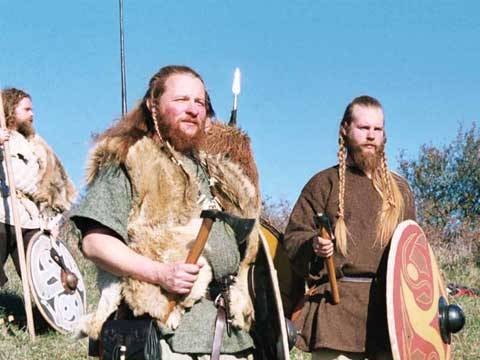
Les rites d'initiation germaniques
00:05 Publié dans archéologie, Histoire, Traditions | Lien permanent | Commentaires (0) | Tags : archéologie, histoire, moyen âge, germanie, germanie antique, tradition, traditions, traditionalisme, initiation, chevalerie |  |
|  del.icio.us |
del.icio.us |  |
|  Digg |
Digg | ![]() Facebook
Facebook
dimanche, 25 septembre 2011
Kampf um Germanien
Kampf um Germanien
00:05 Publié dans archéologie, Histoire | Lien permanent | Commentaires (0) | Tags : antiquité, rome, rome antique, germanie, germanie antique, histoire, allemagne |  |
|  del.icio.us |
del.icio.us |  |
|  Digg |
Digg | ![]() Facebook
Facebook
mardi, 19 avril 2011
Ptolemaios Germania-Karte entschlüsselt?
Ptolemaios Germania-Karte entschlüsselt?
VON: DK - ex: http://www.tojaburg-ev.de/
Geodäsie identifiziert zahlreiche germanische Städte des Altertums
 Die norwegische Insel Smola - das Thule Pytheas? |
Neben Tacitus „Germania“ ist die „Geographie“ des Ptolemaios (ca. 100-170) die grundlegende Überlieferung zu den alten Germanen. Während Tacitus seinen Fokus auf den Menschen legte, ist die Überlieferung des griechischen Autoren die ausführlichste topographische Beschreibung von weltweit insgesamt 6300 Siedlungen in 84 Regionen. In seinem zweiten buch befindet sich die Darstellung der nicht zum Römischen Reich gehörenden Germanischen Städte (Germania Megalé) zwischen Rhein und Weichsel.
Trotz der von Ptolemaios vermerkten Koordinaten gelang es bislang nicht, die insgesamt 94 genannten Ortschaften heutien Städten zuzuordnen, denn die verwendeten Daten sind gegenüber heutigen Koordinaten verzerrt. Zum einen weicht der damalige nullmeridian vom heutigen ab, zum anderen unterliefen dem Karthographen Maßstabsfehler aufgrund der Unterschätzung des Erdumfanges. Das Gebiet Germaniens ist bei ihm zu schmal und langgestreckt. Dazu kommt, daß die meisten der ptolemäischen Orte in keiner anderen antiken Quelle genannt werden und zudem die heutigen Namen oft nicht den früheren entsprechen.
Dank eines mathematischen Umrechneverfahrens gelang es nun Berliner Geodäten, einen großen Teil der germanischen städte genau zu lokalisieren. Die Forscher rechneten die Abweichungen zwischen Ptolemaios und heutigen Koordinaten von in Abgleich mit dem sogenannten Barrington-Atlas bereits identifizierten Orten auf die Vielzahl nicht identifizierter Orte hoch.
Zu den lokalisierten Orten zählen Mörs-Asberg (Asciburgium), ein Ort, direkt am Rhein, der der Sage nach von Odysseus gegründet worden sei, Borken (Mediolanium) Aalen (Cantioebis) und Donauwörth (Brodeltia). Der Großteil der Lokalisierungen bleibt allerdings unsicher, so daß die Autoren die alten Ortsbezeichnungen „bei“ bekannten Städten ansiedeln, wie im Falle von Hildesheim (Ascalingium) oder Braunschweig (Tulisurgium).
Erstaunlich mutet dabei die Nennung der drei bedeutendsten Städte innerhalb des freien Germaniens an: Brünn (Eburodunum), Geismar bei Fritzlar (Amisia) und Bernburg (Saale) (Luppia).
Während in der Nähe von Fritzlar der Missionar Bonifatius der Legende nach im Jahr 723 die Donar-Eiche des Stammesheiligtums der Chatten fällte und Brünn als alte Station einer Bernsteinstraße gilt, fällt Bernburg aus der Reihe. Zwar wird 806 der Stadtteil Waldau als militärisches Zentrum in einer Klosterchronim erwähnt, allerdings fehlt es an einem bedeutenden Handelsweg.
Fraglich erscheint allerdings die zuordnung von Budoris mit dem Drachenfels (Siebengebirge) bei Königswinter, den die Autoren fälschlich bei Bad Dürkheim verorten. Ebenso erschließt sich dem Leser die Identifizierung von Navalia als Essen-Hinsel (heute Essen-Überruhr-Hinsel), nicht so recht, auch wenn es archäologische Befunde eines germanischen Gräberfeldes stützen.
Schließlich erscheint auch die gleichsetzung der vor Trondheim liegenden norwegischen Kleininsel Smola mit dem Thule des Pytheas als äußerst fragwürdig. Angesichts der literarischen Bedeutung des mythischen Ortes Thule dürfte die Gleichsetzung mit der geschichtlich unbedeutenden Smola auf den mehr mathematischen als hostorischen hintergrund der Autoren hindeuten – zumal die Entfernung von Britannien nach Smola etwa genau der Entfernung von Britannien nach Island entspricht und auch Grönland nicht viel weiter entfernt liegt.
In der Bilanz ist der Wert der Veröffentlichung aber insofern nicht zu unterschätzen, als daß er eine neue Diskussionsgrundlage für die Deutung der ptolemaischen Germania-Karte liefert.
Links:
www.zdf.de/ZDFmediathek/beitrag/video/1218320/Germania+war+anders
00:05 Publié dans archéologie | Lien permanent | Commentaires (0) | Tags : grèce antique, antiquité grecque, géographes grecs, germanie antique, cartographie, cartes, géographie, archéologie, allemagne |  |
|  del.icio.us |
del.icio.us |  |
|  Digg |
Digg | ![]() Facebook
Facebook



